Archive
Foster Waterman Stearns
- Foster
- Waterman
- Stearns
Foster W. Stearns, Foster Stearns
- 29-07-1881
- Hull (US)
- 04-06-1956
- Exeter (US)
- LibrarianDiplomatCollectorPolitician
Foster W. Stearns not only actively supported Russian-speaking émigré artists in Istanbul but also assembled a collection of their works which has survived to this day.
Word Count: 26

Foster Waterman Stearns, by Nikolai Becker, 1923. Foster Waterman Stearns was the third secretary of the American Embassy in Istanbul from 1921 to 1923 (© Courtesy of the Holy Cross Archives, Worcester, MA. All Rights Reserved). 
Foster Waterman Stearns, by Nikolai Becker, 1923. Foster Waterman Stearns was the third secretary of the American Embassy in Istanbul from 1921 to 1923 (© Courtesy of the Holy Cross Archives, Worcester, MA. All Rights Reserved). 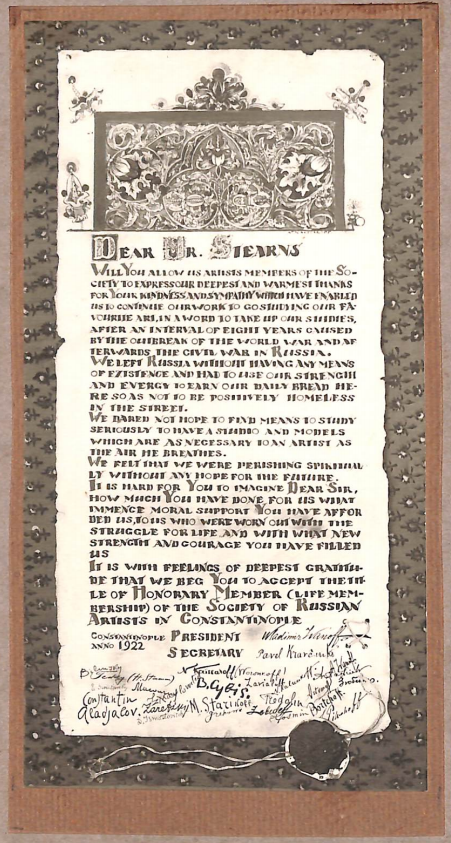
Formal letter of thanks to Foster Waterman Stearns from the members of the Union of Russian Painters in Constantinople, 1922. Source: Scrapbook “To Mr. and Mrs. Stearns from Russian Painters”, p. 2 (Stearns Family Papers. Archives & Special Collections. The College of the Holy Cross). 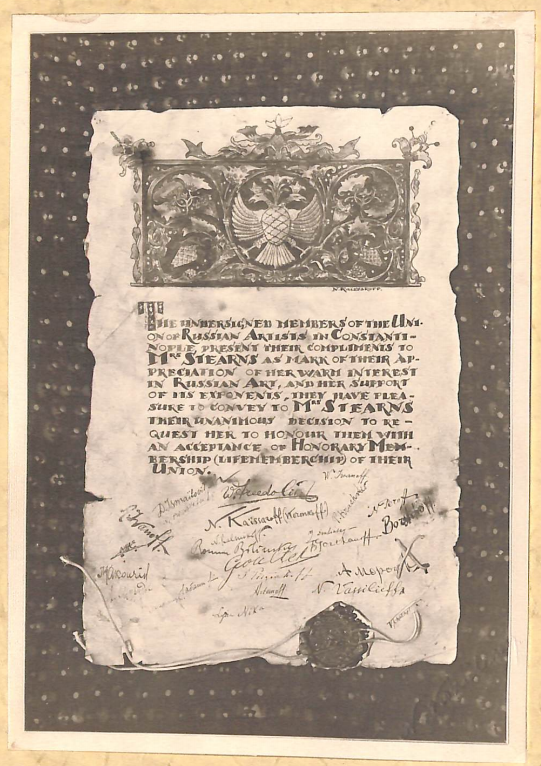
Formal letter of thanks to Martha Stearns from the members of the Union of Russian Painters in Constantinople, 1922. Source: Scrapbook “To Mr. and Mrs. Stearns from Russian Painters”, p. 9 (Stearns Family Papers. Archives & Special Collections. The College of the Holy Cross). 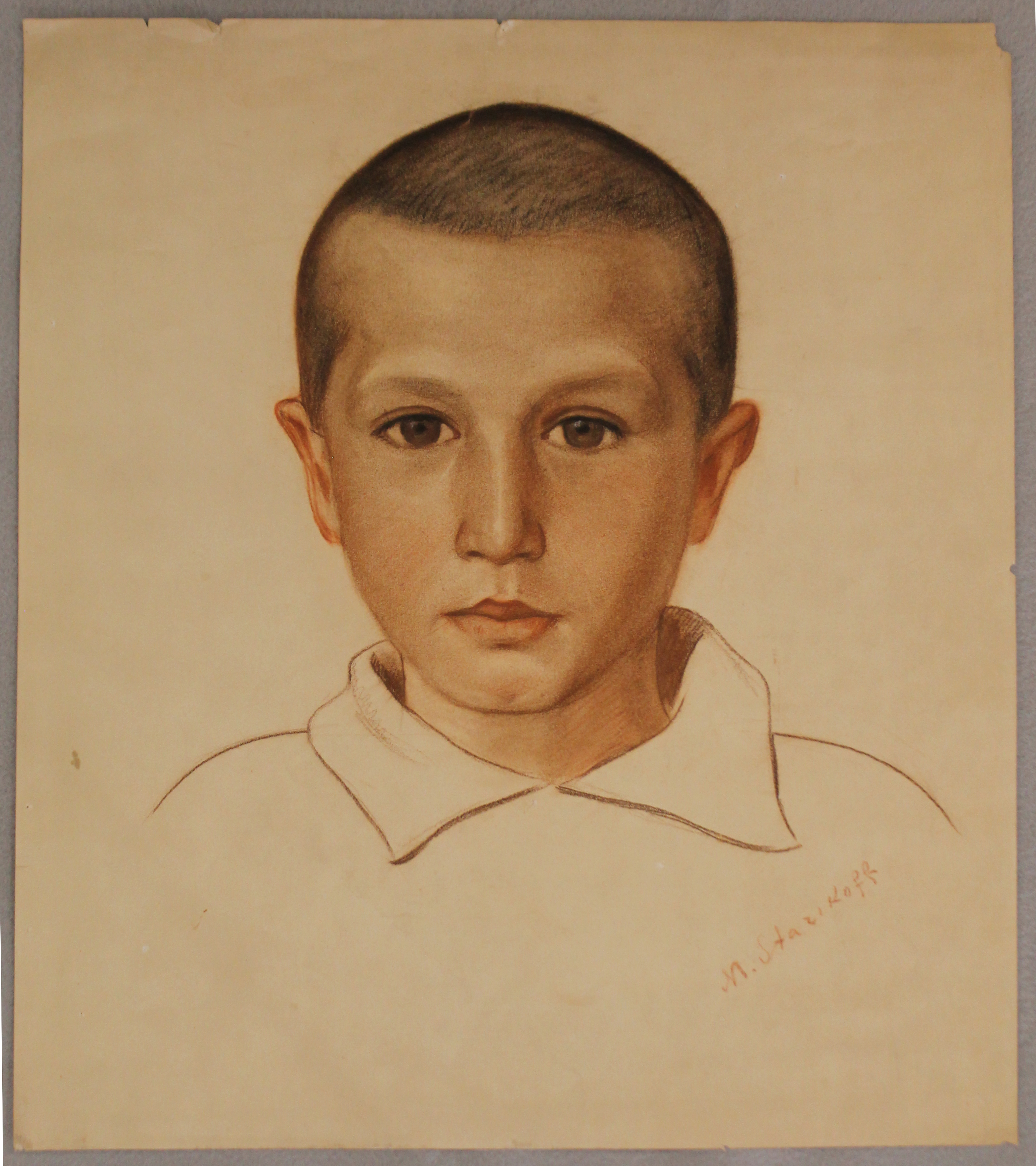
Portrait by Mikhail Starikoff, Istanbul, most likely 1921/1922. Mikhail Starikoff was a Russian émigré artist who first settled in Istanbul where he was a member of the Union of Russian Painters in Constantinople and later moved to France (Stearns Family Papers. Archives & Special Collections. The College of the Holy Cross). 
Work by Alexandre Pankoff, Istanbul, 1922. Alexandre Pankoff was an émigré artist from the Russian Empire and a member of the Union of Russian Painters in Constantinople who is famous for his colour frontispiece for Memoirs of Halide Edib (Stearns Family Papers. Archives & Special Collections. The College of the Holy Cross). 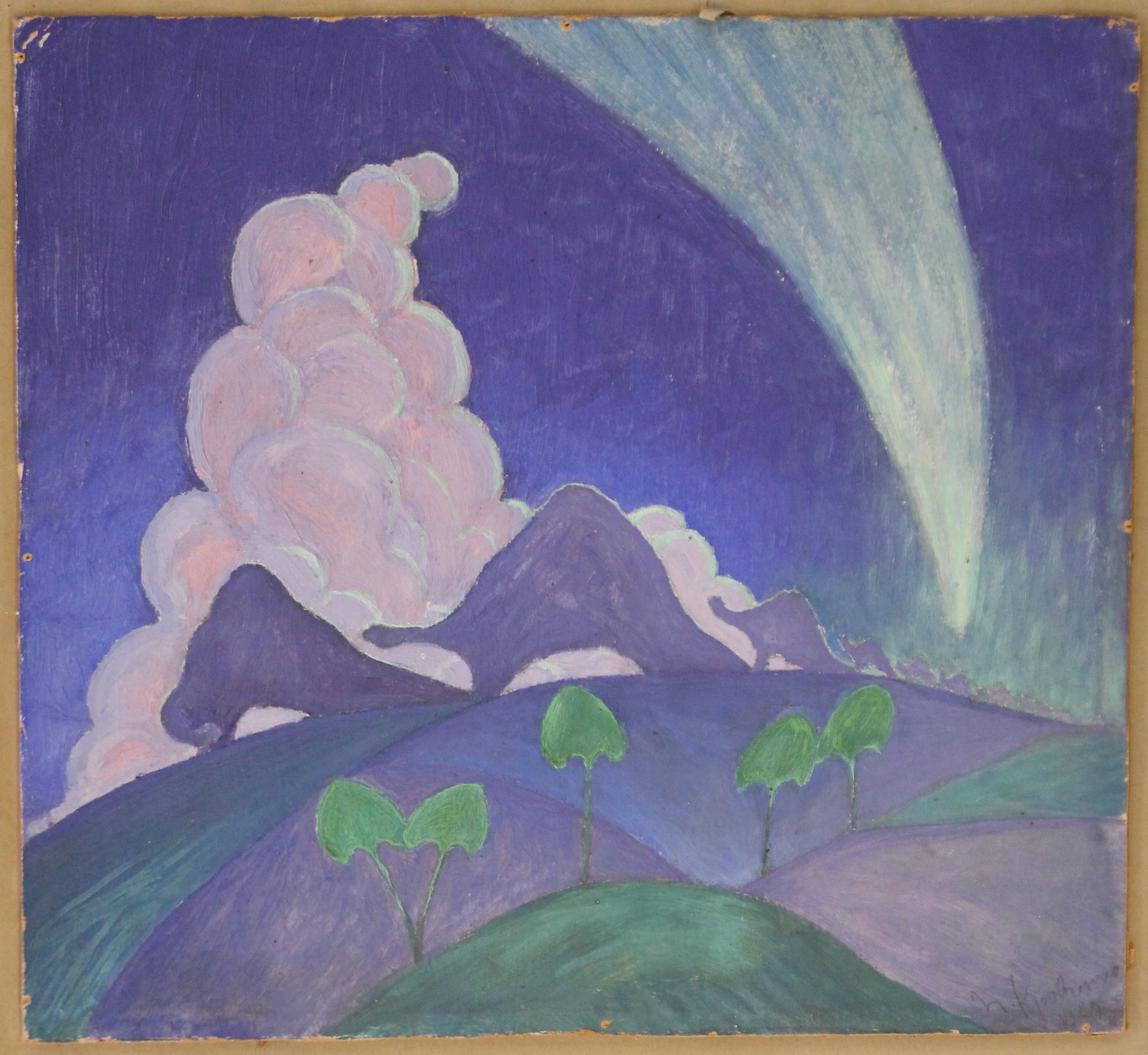
Landscape by Pavel Kravchenko, Istanbul, 1922. The writing on the back is indecipherable, but most likely says: “The Asian Shore of the Bosphorus”. Pavel Kravchenko was an émigré artist from the Russian Empire and a secretary of the Union of Russian Painters in Constantinople. His fate is unknown (Stearns Family Papers. Archives & Special Collections. The College of the Holy Cross). 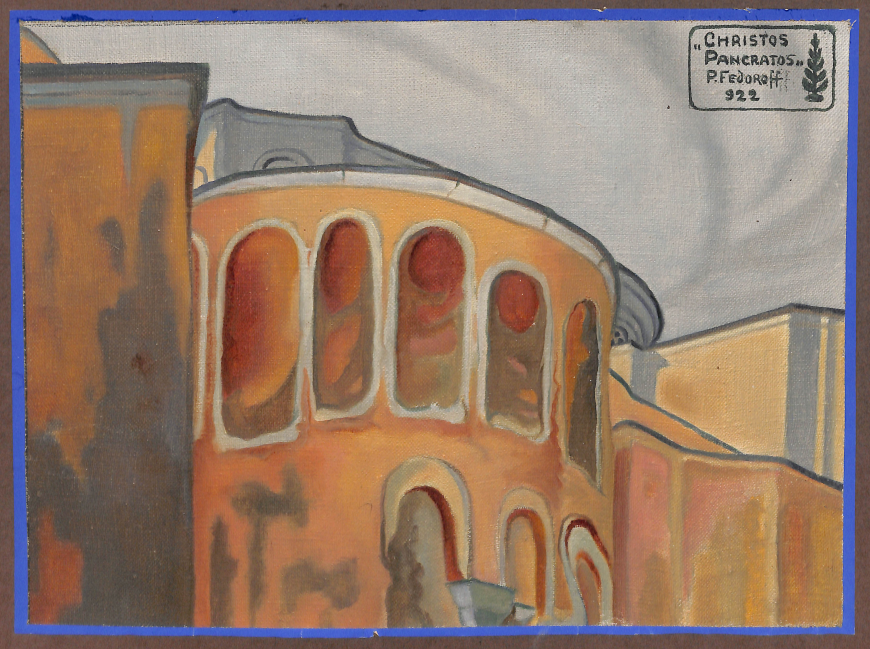
Christos Pancratos (Zeyrek Mosque / Monastery of the Pantocrator) by P. Fedoroff, Istanbul, 1922. P. Fedoroff was an émigré artist from the Russian Empire and a member of the Union of Russian Painters in Constantinople. Presumably he was Pyotr Fedoroff, who settled in Paris in 1924 and mainly worked as a painter of icons (Stearns Family Papers. Archives & Special Collections. The College of the Holy Cross). 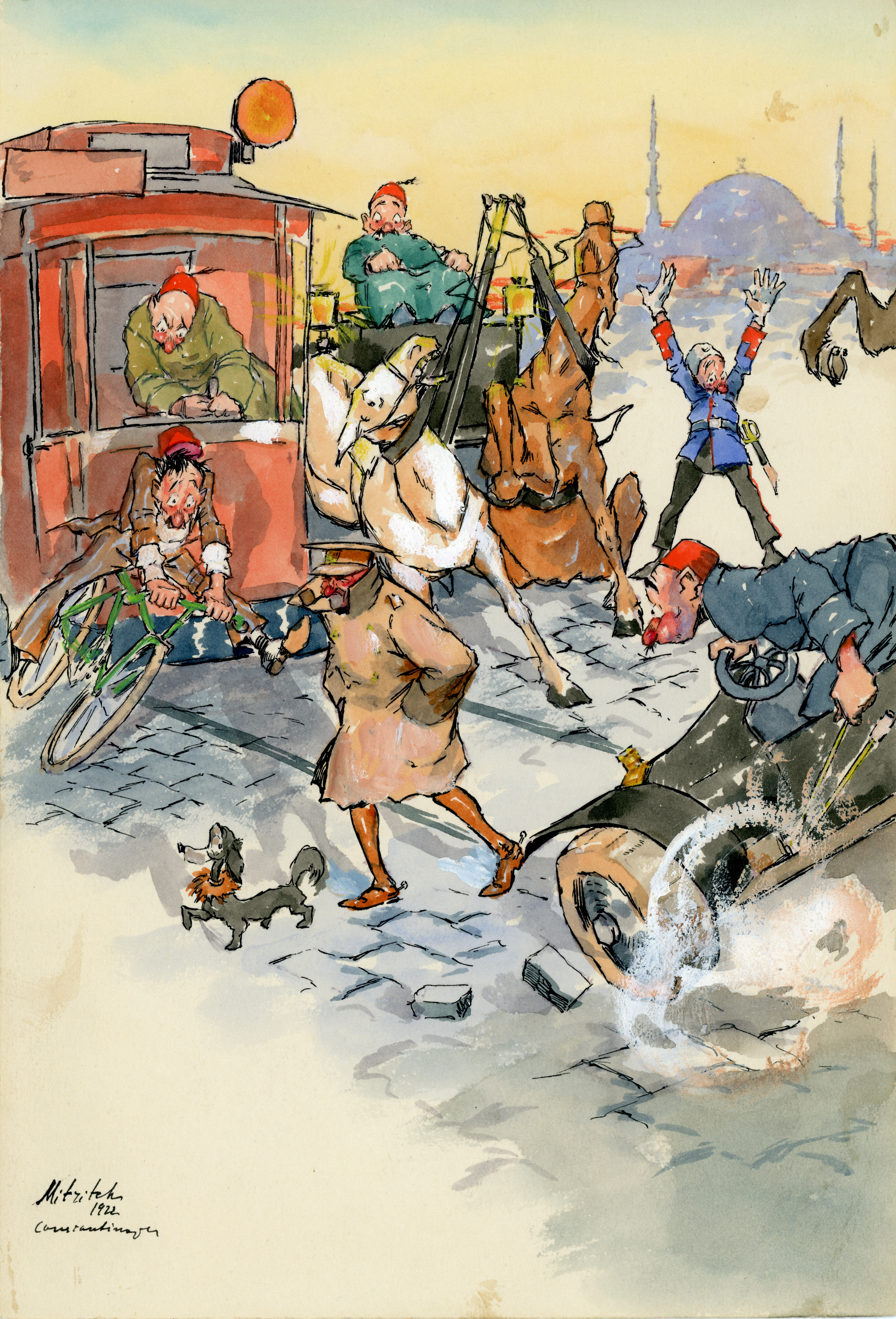
Caricature by Mitritch Karelin, Istanbul, 1922. Mitritch Karelin was an émigré artist from the Russian Empire and a member of the Union of Russian Painters in Constantinople. Presumably, Mitritch is a pseudonym, and this caricature (as well as others from this series on Istanbul) was created by Vladimir Kadulin, who liked to use different brush names (Stearns Family Papers. Archives & Special Collections. The College of the Holy Cross). 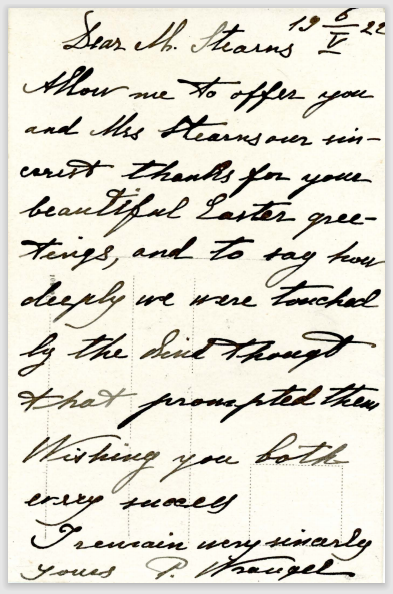
Letter from Pyotr Wrangel to Foster Waterman Stearns, Box 2, Folder 2 of Stearns Family Papers (Stearns Family Papers. Archives & Special Collections. The College of the Holy Cross). Anonymous. “Vystavka Soyuza Russkih Hudojnikov.” Presse du Soir, 19 June 1922, n.p.
Anonymous. “V Soyuze Hudojnikov.” Presse du Soir, 29 June 1922, n.p.
Anonymous. “Témoignage de sa gratitude de l’Association des Peintres russes à M. Stearns.” Presse du Soir, 27 November 1922, n.p.
Bournakine, Anatoliy, and Dominic Valery, editors. Al’manah Na Proschaniye. The Farewell Almanac. L’Almanach Nos Adieux (1920–1923). Imp. L. Babok & fils, 1923.
Word Count: 63
Archives & Special Collections at the College of the Holy Cross (Worcester, Massachusetts).
Slavonic Library (Slovanská knihovna) in Prague.
Word Count: 19
I wish to express my most sincere gratitude to the representatives of the Archives & Special Collections at the College of the Holy Cross (Worcester, Massachusetts) for their enormous assistance.
Word Count: 30
Kabristan Street 570 (now Meşrutiyet Caddesi 56), Beyoğlu, Istanbul (place of work, 1921–1923).
- Istanbul
- Ekaterina Aygün. "Foster Waterman Stearns." METROMOD Archive, 2021, https://archive.metromod.net/viewer.p/69/2949/object/5138-11017193, last modified: 15-04-2021.
-
Nikolai BeckerPainterGraphic ArtistIstanbul
Nikolai Becker worked tirelessly in Turkey for three years. He created at least 168 portraits of men and women (among them admirals and their families, commanders-in-chief, diplomats, etc.).
Word Count: 27
Exhibition of Russian émigré artists at Taksim Military BarracksExhibitionIstanbulThe exhibition of Russian-speaking émigré artists at Taksim Military Barracks was the first major exhibition organised by the Union of Russian Painters in Constantinople.
Word Count: 24
Union of Russian Painters in ConstantinopleAssociationIstanbulThe Union existed for less than two years but in that short space of time a tremendous amount of work was done by its members, refugees from the Russian Empire.
Word Count: 30
Pera Palace HotelHotelIstanbulThe Pera Palace was the gem of Pera district where people gathered to wine and dine and be entertained, as well as to discuss the issues of the day.
Word Count: 29
Dimitri IsmailovitchPainterArt HistorianIstanbulIn Istanbul, Ismailovitch became one of the leaders of the Union of Russian Painters in Constantinople, organised three solo exhibitions, and made contribution to the study of Byzantine art.
Word Count: 29